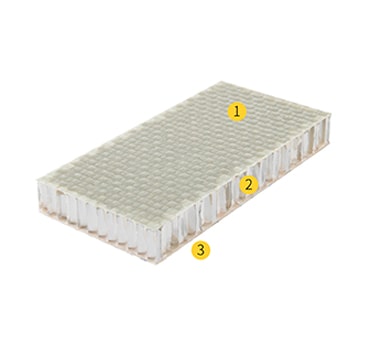Fiberglass honeycomb panels consists of two layers of fiberglass sheets, or one layer fiberglass and the other aluminum sheets, with aluminum honeycomb core in between. This type of panel is designated for backing of stone veneer panels for exterior cladding. Fiberglass itself has similar thermal conductivity with natural stone, therefore even under rapid temperature changes outdoor, stone and fiberglass move along in similar ranges, with keeps the stone veneer panel as a whole keeping straight with minimum bowing.
KCP manufactures honeycomb fiberglass panels with renowned adhesive from trustworthy suppliers. It is the ideal choice for those who needs backing panels for lamination of their own stone panels.

KCP’s fiberglass honeycomb panel is a sandwich structure consist of two layer of fiberglass sheets; Or alternatively one layer fiberglass sheet and the other aluminum sheets, and aluminum honeycomb core in between. All layers are bonding with modified epoxy adhesive to make the panel as a whole.
The elder version of fiberglass honeycomb panels available on the market use resin to apply onto fiberglass sheets to form the fiberglass layer. While the resin itself is always the weakest point of the panel as a whole – It usually fails at around 1.2MPa during flatwise tensile strength tests. This is not an ideal statistic especially for exterior cladding panels.
KCP now offers its new-generation fiberglass panels which uses modified epoxy to apply with fiberglass sheets. It is way stronger than the traditional resin. As a result, the tensile strength that can be achieved by our panels reach to 2.5MPa – which is 2 times stronger than the elder version.
Additionally, the choice of aluminum as the core material ensures superb fire resistance, an essential property for many applications.
Our fiberglass honeycomb panels come in two configurations for varied needs: panels with fiberglass on both sides and panels with one side fiberglass and the other aluminum.
A unique specification for the panels with one aluminum side is the drum peeling strength, which measures 60N.mm/mm. This attribute gauges the panel’s resistance to delamination forces and is not applicable to double-sided fiberglass panels.
Both configurations have a flexural strength of 60Mpa, showing their ability to resist bending and deformation under various loads.
The potential applications for these fiberglass honeycomb core panels are expansive, capitalizing on the advantages of their lightweight, high-strength, and insulating properties.
KCP’s fiberglass honeycomb panels are more than the sum of their parts. They are optimized to deliver unparalleled performance in a wide array of applications. With a robust structure, finely calibrated specifications, and a broad range of uses, these panels set a new industry standard for quality and versatility.